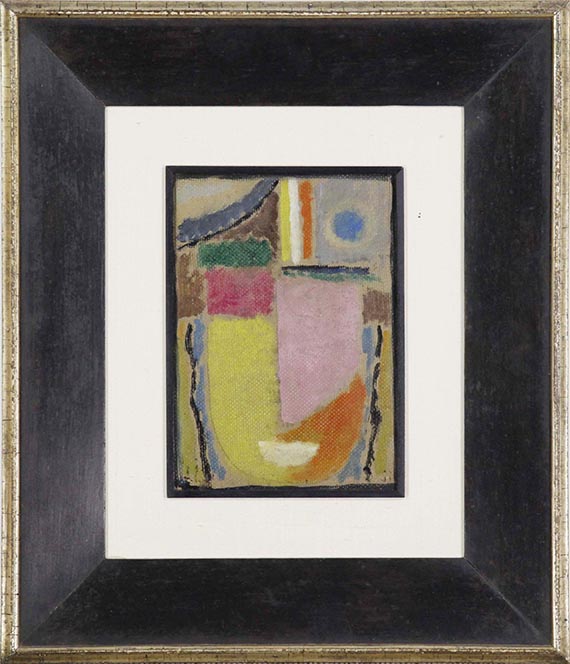Frame image
404
Alexej von Jawlensky
Abstrakter Kopf, 1933.
Oil on cardboard
Estimate:
€ 60,000 / $ 69,600 Sold:
€ 114,300 / $ 132,588 (incl. surcharge)
Abstrakter Kopf. 1933.
Oil on cardboard.
Lower left monogrammed and lower right dated. With an oil study of a rustic wardrobe and the inscription "12" on the reverse. 22 x 15.5 cm (8.6 x 6.1 in).
• A particularly color-intense copy from the important series of the "Abstract Heads".
• Jawlensky left classic portraiture behind him in a radical manner.
• Harmonious composition in an appealing symmetry informed by geometry.
• In 1933 present from Jawlensky to the art historian and friend Mela Escherich.
PROVENANCE: Mela Escherich Collection, Wiesbaden (gifted from the artist in 1933).
Estate of Mela Escherich, Wiesbaden (since 1956).
Hanna Bekker vom Rath Collection, Hofheim im Taunus.
Private collection.
Private collection (acquired from the above in 1989).
Private collection Southern Germany (acquired from the above in 1992).
LITERATURE: Maria Jawlensky/Lucia Pieroni-Jawlensky/Angelica Jawlensky, Alexej Jawlensky. Catalogue Raisonné of the Oil Paintings, vol. II (1914-1933), Munich 1992, p. 481, no. 1417 (color illu. p. 493).
Sotheby's, London, November 29, 1989, lot 199 (color illu.).
Grisebach, Berlin, 24th auction, May 29, 1992, lot 63 (color illu.).
Mela Escherich, in: Der Cicerone, year XVIII, 1926, quoted from: Clemens Weiler, Köpfe-Gesichte-Meditationen, Hanau 1970, p. 129.
Oil on cardboard.
Lower left monogrammed and lower right dated. With an oil study of a rustic wardrobe and the inscription "12" on the reverse. 22 x 15.5 cm (8.6 x 6.1 in).
• A particularly color-intense copy from the important series of the "Abstract Heads".
• Jawlensky left classic portraiture behind him in a radical manner.
• Harmonious composition in an appealing symmetry informed by geometry.
• In 1933 present from Jawlensky to the art historian and friend Mela Escherich.
PROVENANCE: Mela Escherich Collection, Wiesbaden (gifted from the artist in 1933).
Estate of Mela Escherich, Wiesbaden (since 1956).
Hanna Bekker vom Rath Collection, Hofheim im Taunus.
Private collection.
Private collection (acquired from the above in 1989).
Private collection Southern Germany (acquired from the above in 1992).
LITERATURE: Maria Jawlensky/Lucia Pieroni-Jawlensky/Angelica Jawlensky, Alexej Jawlensky. Catalogue Raisonné of the Oil Paintings, vol. II (1914-1933), Munich 1992, p. 481, no. 1417 (color illu. p. 493).
Sotheby's, London, November 29, 1989, lot 199 (color illu.).
Grisebach, Berlin, 24th auction, May 29, 1992, lot 63 (color illu.).
Mela Escherich, in: Der Cicerone, year XVIII, 1926, quoted from: Clemens Weiler, Köpfe-Gesichte-Meditationen, Hanau 1970, p. 129.
From the beginning on, Alexej von Jawlensky consistently pursued only three subjects: the still life, the landscape and the portrait. He increasingly turned to portraits, which he revisited in meditations, variations and in serial works, until his death in Wiesbaden in 1941. As early as in 1914 while in exile in Switzerland, he made first “Savior Faces” and “Mystical Heads” in which he would almost completely overcome the portrait character of previous heads. As a logical consequence, he made another step towards abstraction and the development of color field painting with the “Abstract Heads” made between 1918 and 1933. Our "Abstract Head" from 1933 combines a particularly exciting play of cheerful colors on the one hand, and inner contemplation on the other. Jawlensky entirely removed the scheme, taken from traditional Russian icons, from all naturalistic representation. In search of depth of expression, he broke facial features into geometric shapes and rearranged in an almost architectural symmetry. With a composition of sharp lines and finely coordinated color fields, Jawlensky's art reached a mythical level at which he made the invisible tangible. This topic also concerned the art historian Mela Escherich, writer and friend of Jawlensky, who was among the work’s early owners. After they had met in the early 1920s, the two like-minded people became close friends. Escherich provided him with reading material as well as with financial support and, as Jawlensky became increasingly ill, she was one of his so-called "emergency helpers". In return for her help, the artist gave her pictures such as the present "Abstract Head" from 1933. Even after his death, she acted as a tireless supporter and even made first efforts to compile a catalogue raisonné. So it's not just the special expressiveness of the work that gives it such a spirited character, but also the exciting provenance and the unique background story. [AW]
404
Alexej von Jawlensky
Abstrakter Kopf, 1933.
Oil on cardboard
Estimate:
€ 60,000 / $ 69,600 Sold:
€ 114,300 / $ 132,588 (incl. surcharge)
Headquarters
Joseph-Wild-Str. 18
81829 Munich
Phone: +49 89 55 244-0
Fax: +49 89 55 244-177
info@kettererkunst.de
Louisa von Saucken / Undine Schleifer
Holstenwall 5
20355 Hamburg
Phone: +49 40 37 49 61-0
Fax: +49 40 37 49 61-66
infohamburg@kettererkunst.de
Dr. Simone Wiechers / Nane Schlage
Fasanenstr. 70
10719 Berlin
Phone: +49 30 88 67 53-63
Fax: +49 30 88 67 56-43
infoberlin@kettererkunst.de
Cordula Lichtenberg
Gertrudenstraße 24-28
50667 Cologne
Phone: +49 221 510 908-15
infokoeln@kettererkunst.de
Hessen
Rhineland-Palatinate
Miriam Heß
Phone: +49 62 21 58 80-038
Fax: +49 62 21 58 80-595
infoheidelberg@kettererkunst.de
We will inform you in time.




 Lot 404
Lot 404 
